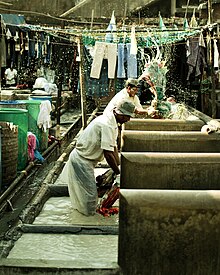Dhobi Ghat
 From Wikipedia the free encyclopedia
From Wikipedia the free encyclopedia
18°58′58.52″N 72°49′31.47″E / 18.9829222°N 72.8254083°E



Dhobi Ghat is an open air laundry in Mumbai, India.[1] It was constructed in 1890.[2] The washers, known as dhobis, work in the open to clean clothes and linens from Mumbai's hotels and hospitals.
The phrase dhobi ghat is used all over India to refer to any place where many washers are present. Inspired by the Mumbai Dhobi Ghat (then Bombay), the British built Dhobi Ghat in Kolkata (then Calcutta) in 1902[3] and there are other dhobi ghat places all over southern Asia.
Overview
[edit]There are rows of open-air concrete wash pens, each fitted with its own flogging stone. Claimed to be the world's largest outdoor laundry, Dhobi Ghat is a very popular attraction among foreign tourists.
It is located next to Mahalaxmi railway station on the Western Railway suburban line in southern Mumbai. It is also accessible from the Jacob Circle monorail station. It is near Saat Rasta roundabout.
The Dhobi Kalyan & Audhyogik Vikas Cooperative Society, the apex body that represents washermen, estimates the annual turnover of the Mahalaxmi Dhobi Ghat at around Rs 100 crore. For 18 to 20 hours each day, over 7,000 people flog, scrub, dye and bleach clothes on concrete wash pens, dry them on ropes, neatly press them and transport the garments to different parts of the city. Over one lakh (100,000) clothes are washed each day. Some of the wealthier dhobis have given up on manual cleaning and have now installed large mechanical washing and drying machines. The dhobis collect clothes from all corners of the city, from Colaba to Virar. Their biggest clients are neighbourhood laundries, garment dealers, wedding decorators and caterers, and mid-sized hotels and clubs.[2]
Dhobi Ghat garnered a Guinness Book of World Records entry under ‘most people hand-washing clothes at a single location’ in 2011. In 2013, World Records India and World Amazing Records honoured World Record Certificate to Dhobi Kalyan & Audhyogik Vikas Co – op. Society Ltd.[4]
The Saat Rasta Project is a proposed Public Space Project along the Bapurao Jagtap Road, connecting Jacob Circle to the Mahalaxmi Railway Station. This public space will connect to Dhobi Ghat, which is also a major tourist attraction.
Home to the dhobis and their families (around 200 families), the Dhobi Ghat has seen this occupation passed down from one generation to the next. The best time to visit Dhobi Ghat is early morning and early afternoon. While the dhobis are in action in the morning to take care of the washing load, the early afternoons are an ideal time to see the clothes dry.[2]
See also
[edit]- Dhoby Ghaut, Singapore
- Dhoby Ghaut, Penang, Malaysia
References
[edit]- ^ "Mumbai boasts the world's largest open air laundry". The Globe and Mail. 8 November 2010. Retrieved 28 August 2014.
- ^ a b c Bharucha, Nauzer (26 February 2017). "Did you know Mumbai's Dhobi Ghat still makes Rs 100 crore a year?". The Times of India. Retrieved 15 June 2018.
- ^ "Archived copy". Archived from the original on 19 April 2021. Retrieved 2 March 2020.
{{cite news}}: CS1 maint: archived copy as title (link) - ^ World Records India.